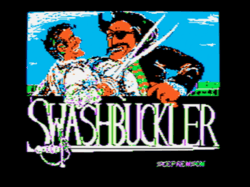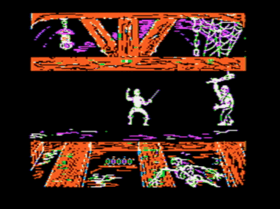Swashbuckler (video game)
| Swashbuckler | |
|---|---|
 Title screen | |
| Developer(s) | Paul Stephenson[1] |
| Publisher(s) | Datamost |
| Platform(s) | Apple II |
| Release date(s) | 1982 |
| Genre(s) | Fighting |
| Mode(s) | Single player |

Swashbuckler is an early fighting game for the Apple II family of computers, created by Paul Stephenson and published by Datamost in 1982.
The player controls a sword-wielding swashbuckler who must fight and dispatch various attackers. Combat occurs in a wooden-beamed ship's hold littered with skeletons and cobwebs, which the player views from the side.
The Apple II version of the game was translated into Bulgarian under the name "Авантюрист" (Adventurer).
Gameplay
The fighter's actions are controlled with the keyboard, and include moving left or right (A and D), turning (S) and swinging the sword high (I), low (M), or lunging straight (L). The first opponent is a large, lumbering man with a spiked club; once defeated, the second opponent appears, a smaller man armed with a hatchet and a dagger. After defeating him, both return and attack together. As play progresses, more opponents are added to the fray, including enormous rats and venomous snakes. Eventually the swashbuckler progresses out of the hold to the sunlit deck, though opponents continue to be a major threat.
For each enemy dispatched, the game awards a point. The swashbuckler can withstand two hits, but the third kills him and ends the game. The difficulty steadily increases until he's overwhelmed.
Reception
Computer Gaming World gave the game a glowing review, only lamenting the rollover of the five-digit score at 250 (which was fixed prior to final publication), appended by an editor's note that, although the graphics were superb and the concept somewhat unique, the players at CGW grew tired of the lack of variety after a few dozen kills.[2]
References
- ↑ "The Giant List of Classic Game Programmers".
- ↑ Cranford, Michael (May–June 1982), "Swashbuckler: A Different Kind of Piracy", Computer Gaming World, pp. 36–37